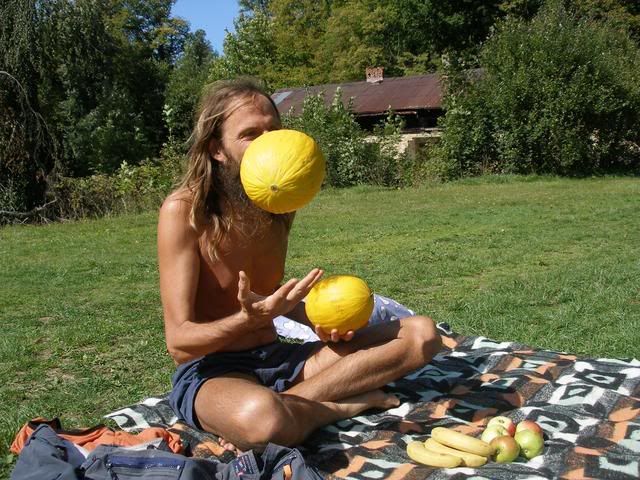Here's a wonderful chart showing our anatomical / physiological / taxonomical classification as frugivores..
It's a comparative anatomy chart, comparing the carnivores, omnivores, herbivores and frugivores, and it should be abundantly clear that we are neither Lions, nor tigers nor bears, oh my! So all those people screaming balance of nature as justification for eating other animals, please recognise that by choosing to eat the butchered remains of other animals, you are actually upsetting the balance of nature, not aiding it!
Showing posts with label chart. Show all posts
Showing posts with label chart. Show all posts
Monday, August 03, 2015
Comparative Anatomy of Carnivores, Omnivores, Herbivores, Frugivores and Humans ..
Posted by
Fruitarian Mango
at
Monday, August 03, 2015
5
comments
![]()
![]()
Labels: anatomical, anatomy, carnivore, chart, frugivore, Nature, omnivore, physiological, physiology, taxonomy
Friday, November 30, 2007
Another Physiological/Anatomical Comparison Chart.. this time with fruitarians..
Anatomical Chart Comparison of Human and Carnivore/Omnivor/Herbivore/Frugivore
| CARNIVORA | OMNIVORA | HERBIVORA | FRUGIVORA (APES) | MAN |
| Zonary placenta | Placenta non-acciduate | Placenta non-deciduate | Discoidal placenta | Discoidal placenta |
| Four Footed | Four Footed | Four footed | Two hands and two feet | Two hands and two feet |
| Have claws | Have hoofs | Have hoofs (cloven) | Flat nails | Flat nails |
| Go on all fours | Go on all fours | Go on all fours | Walks upright | Walks upright |
| Have tails | Have tails | Have tails | Without tails | Without tails |
| Eyes look sideways | Eyes look sideways | Eyes look sideways | Eyes look forward | Eyes look forward |
| Skin without pores | Skin with pores | Skin with pores (save with pachyderms as the elephant | Millions of pores | Millions of pores |
| Slightly developed incisor teeth | Very well-developed incisor teeth | Well-developed incisor teeth | Well-developed incisor teeth | |
| Pointed molar teeth | Molar teeth in folds | Blunt molar teeth | Blunt molar teeth | |
| *Dental formula 5 to 8.1.6.1.5 to 8 5 to 8.1.6.1.5 to 8 | Dental formula 8.1.2 to 3.1.8 8.1.2 to 3.1.8 | Dental formula 6.0.0.0.6 6.1.6.1.6 | Dental formula 5.1.4.1.5. 5.1.4.1.5. | Dental formula 5.1.4.1.5 5.1.4.1.5 |
| Small salivary glands | Well- developed salivary glands | Well- developed salivary glands | Well- developed salivary glands | Well- developed salivary glands |
| Acid reaction of saliva and urine | Saliva and urine acid | Alkaline reaction, saliva and urine | Alkaline reaction, saliva and urine | Alkaline reaction of saliva and urine |
| Rasping tongue | Smooth tongue | Smooth tongue | Smooth tongue | Smooth tongue |
| Teats on abdomen | Teats on abdomen | Teats on abdomen | Miammary glands on breast | Mammary glands on breast |
| Stomach simple and roundish | Stomach simple and roundish large cul-de-sac | A stomach in three compartments (in camel and some ruminents four) | Stomach with duodenum (as second stomach) | Stomach with duodenum (as second stomach) |
| Intestinal canal 3 times length of the body | Intestinal canal 10 times length of the body | Length of intestinal canal varies according to species, but is usually 10 times longer than body | Intestinal canal 12 times length of the body | Intestinal canal 12 times length-of the body |
| Colon Smooth | Intestinal canal smooth and convoluted | Intestinal canal smooth and convoluted | Colon convoluted | Colon convoluted |
| Lives on flesh | Lives on flesh, carrion and plants | Lives on grass, herbs and plants | Lives on fruit and nuts | Live on fruit! |
*The figures in the center represent the number of incisors upon each side
Hugs,
Mango

Blogged with Flock
Posted by
Fruitarian Mango
at
Friday, November 30, 2007
2
comments
![]()
![]()
Labels: chart, fruitarianism, physiological
Wednesday, November 28, 2007
Physiological/Biological Anatomy of a (fruitarian) Human
Some evidence supporting our basic herbivorous natures:
Anatomical Chart Comparison of Human and Carnivore/Omnivor/Herbivore/Frugivore
| Carnivore | Herbivore | Omnivore | Human | |
| Facial Muscles | Reduced to allow wide mouth gape. | Well developed | Reduced | Well developed |
| Jaw Type | Angle not expanded - Vertically mobile for biting or tearing. | Expanded angle - Laterally mobile to allow chewing of food. | Angle not expanded - Vertically mobile for biting or tearing. | Expanded angle - Laterally mobile to allow chewing of food. |
| Jaw Joint Location | On same plane as molar teeth | Above the plane of the molars | On same plane as molar teeth | Above the plane of the molars |
| Jaw Motion | Shearing; minimal side-to-side motion | No shear; good side-to-side, front-to-back | Shearing; minimal side-to-side motion | No shear; good side-to-side, front-to-back |
| Major Jaw Muscles | Temporalis | Masseter and pterygoids | Temporalis | Masseter and pterygoids |
| Mouth Opening vs. Head Size | Large | Small | Large | Small |
| Teeth: Incisors | Short and pointed | Broad, flattened and spade shaped | Short and pointed | Broad, flattened and spade shaped |
| Teeth: Canines | Long, sharp and curved | Dull and short or long (for defense), or none | Long, sharp and curved | Short and blunted |
| Teeth: Molars | Sharp, jagged and blade shaped | Flattened with cusps vs complex surface | Sharp blades and/or flattened | Flattened with nodular cusps |
| Chewing | None; swallows food whole | Extensive chewing necessary | Swallows food whole and/or simple crushing | Extensive chewing necessary |
| Saliva | No digestive enzymes - Acidic saliva for the digestion of animal protein; the enzyme ptyaline lowly developed salivary glands. | Carbohydrate digesting enzymes - Alkaline salive pour a quick breakdown of food developed Salivary glands for pre-digestion. | No digestive enzymes - Acidic saliva for the digestion of animal protein; the enzyme ptyaline lowly developed salivary glands. | Carbohydrate digesting enzymes - Alkaline salive for a quick breakdown of food developed Salivary glands for pre-digestion. |
| Stomach Type | Simple | Simple or multiple chambers | Simple | Simple |
| Stomach Acidity | Less than or equal to pH 1 with food in stomach | pH 4 to 5 with food in stomach | Less than or equal to pH 1 with food in stomach | pH 4 to 5 with food in stomach |
| Stomach Capacity | 60% to 70% of total volume of digestive tract | Less than 30% of total volume of digestive tract | 60% to 70% of total volume of digestive tract | 21% to 27% of total volume of digestive tract |
| Length of Small Intestine | 3 to 6 times body length | 10 to more than 12 times body length | 4 to 6 times body length | 10 to 11 times body length |
| Colon | Simple, short and smooth | Long, complex; may be sacculated | Simple, short and smooth | Long, sacculated |
| Liver | Can detoxify vitamin A | Cannot detoxify vitamin A | Can detoxify vitamin A | Cannot detoxify vitamin A |
| Kidney | Extremely concentrated urine | Moderately concentrated urine | Extremely concentrated urine | Moderately concentrated urine |
| Nails | Sharp claws | Flattened nails or blunt hooves | Sharp claws | Flattened nails |
| Thermo -stasis | Hyper -ventilation | Perspiration | Hyper -ventilation | Perspiration |
| Vitamin C | Can produce it without vitamin C rich food | Needed from the daily food | Can produce it without vitamin C rich food | Needed from the daily food (fruits). |
| Urine | Acid | Alkaline | Acid | Alkaline |
| Skin | No pores. No transcutaneous sweating. | millions of pores. Glands capable of sweating. | No pores. No transcutaneous sweating. | millions of pores. Glands capable of sweating |
Adapted from The Comparative Anatomy of Eating by Milton R. Mills, M.D.
Although not exactly evidence of our fundamental fruitarian-ness, nevertheless still relevant and interesting.. I'd love to see an additional column labeled fruitarians..
hugs,
mango.
Playing by the lake in the Czech Republic, 2006:

Blogged with Flock
Posted by
Fruitarian Mango
at
Wednesday, November 28, 2007
3
comments
![]()
![]()
Labels: chart, fruitarianism, physiological
Subscribe to:
Posts (Atom)



